Advances in artificial intelligence and machine learning have led to a shift in the way active managers research investments, analyze alpha opportunities, and execute trades.
Although the past decade has seen a drastic rise in passive equity funds over more active forms of asset management, some have argued that AI and machine learning will change that trend. In particular, many say that machine learning will provide traders and investors new tools to outperform passive indexes.
While its unlikely that AI-based algorithms will take over asset management entirely, the shift towards "quantamental investing" is gaining increasing popularity amongst fund managers and retail investors alike.
As discussed in our guide to quantamental investing,
Quantamental investing enables asset managers to take advantage of the advances in data science and machine learning, while still making use of their own discretion, knowledge, and expertise of markets.
While many of the largest hedge funds and asset managers have been using machine learning in their investment approach for years, new tools and platforms are providing access to these technologies to traders and investors of all sizes.
Our own AI investment research platform—MLQ app—provides access to a variety of machine learning algorithms and insights that can be incorporated into the investment process.
In this guide we'll look at 8 applications of machine learning that traders and investors can use in their investment decisions, these include:
- Social Sentiment
- News Sentiment
- SEC Filing Sentiment
- Return Estimates
- Stock Rankings
- Crypto On-Chain Analysis
- Synthetic Data
- Reinforcement Learning
Stay up to date with AI
Data disclaimer: the data provided below is sandbox data and is not financial advice—please see our terms of service for more information.
Sentiment Analysis
Sentiment analysis is one of the most common applications of machine learning for finance. With the massive amounts of text data available of securities and crypto assets, a machine learning technique known as natural language processing (NLP) can be applied to quickly and efficiently analyze the entire corpus of data.
In the context of trading and investing, there are three main use cases for NLP and sentiment analysis:
- Social sentiment
- News sentiment
- SEC filings sentiment
Social Sentiment
Social media has become a main source of information for traders and investors. By analyzing the vast amount of text data from social, this allows investors to quickly gauge an asset's sentiment without having to read through thousands of tweets themselves.
In the MLP app, for example, we provide social sentiment data sourced from StockTwits that provides positive sentiment, negative sentiment, and an overall score:
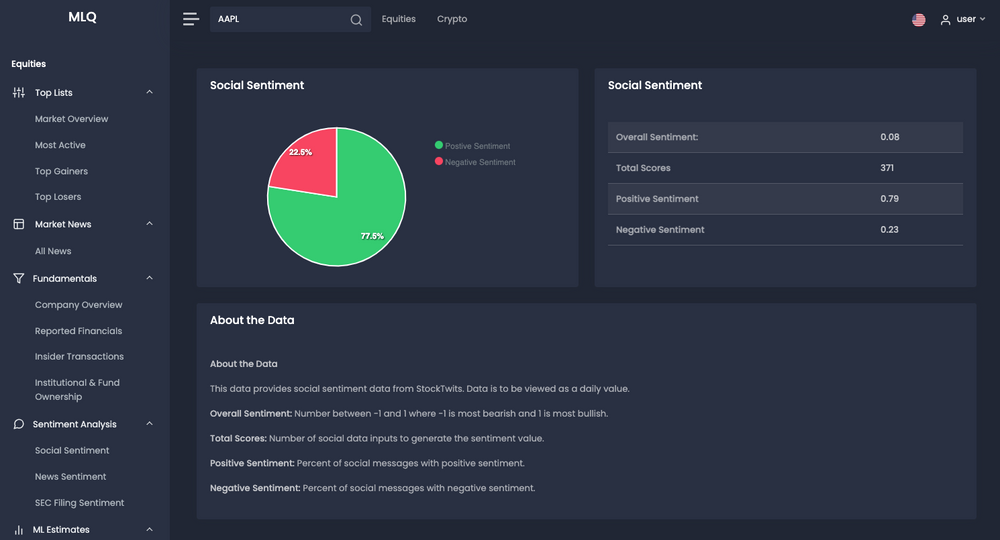
News Sentiment
Another key application of natural language processing for finance is analyzing text data from news sources. With so many news sources available to investors, it can be time-consuming and inefficient to read each source in order to gauge the overall sentiment.
To solve this, the MLQ app provides a news sentiment score for the last 7 and 30 days for over 5000 US stocks:
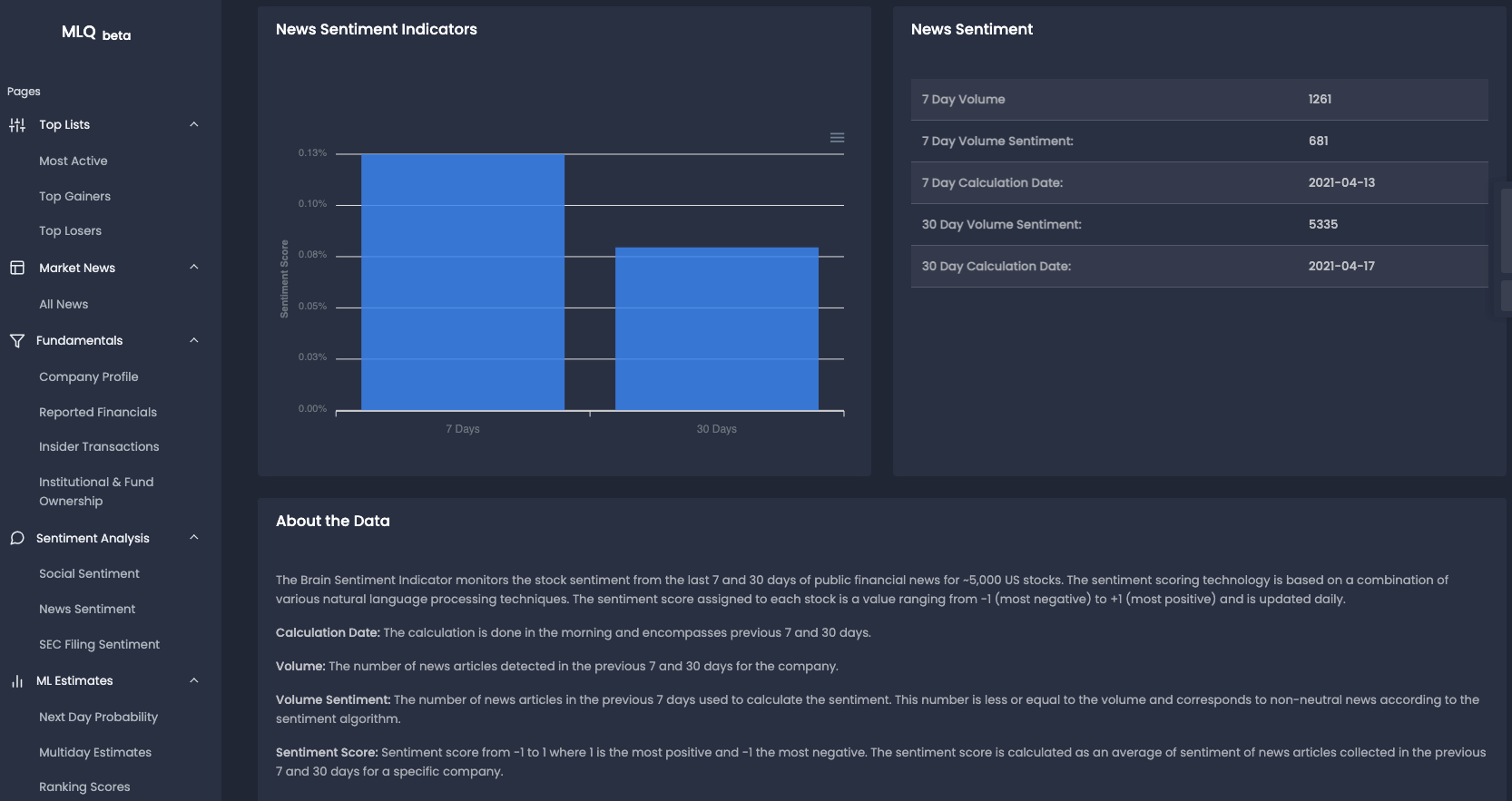
SEC Filings Sentiment
Finally, arguably one of the most valuable applications of sentiment analysis for investing is analyzing SEC filings.
As an analyst, if you're interested in analyzing the quarterly or annual filings of every company in a particular sector, for example, this could take weeks or months to read through each filing.
To speed up the investment research process, using natural language processing for SEC filings allows analysts to quickly review hundreds of filings in a short period of time. After this initial analysis, analysts can then quickly determine which filings may contain interesting information and warrant further investigation.
For example, in the MLQ app, we provide language metrics for each filing including:
- Constraining
- Interesting
- Litigious
- Uncertainty
- Overall sentiment
Below that we also have the similarity and differences in language metrics from the previous filing.
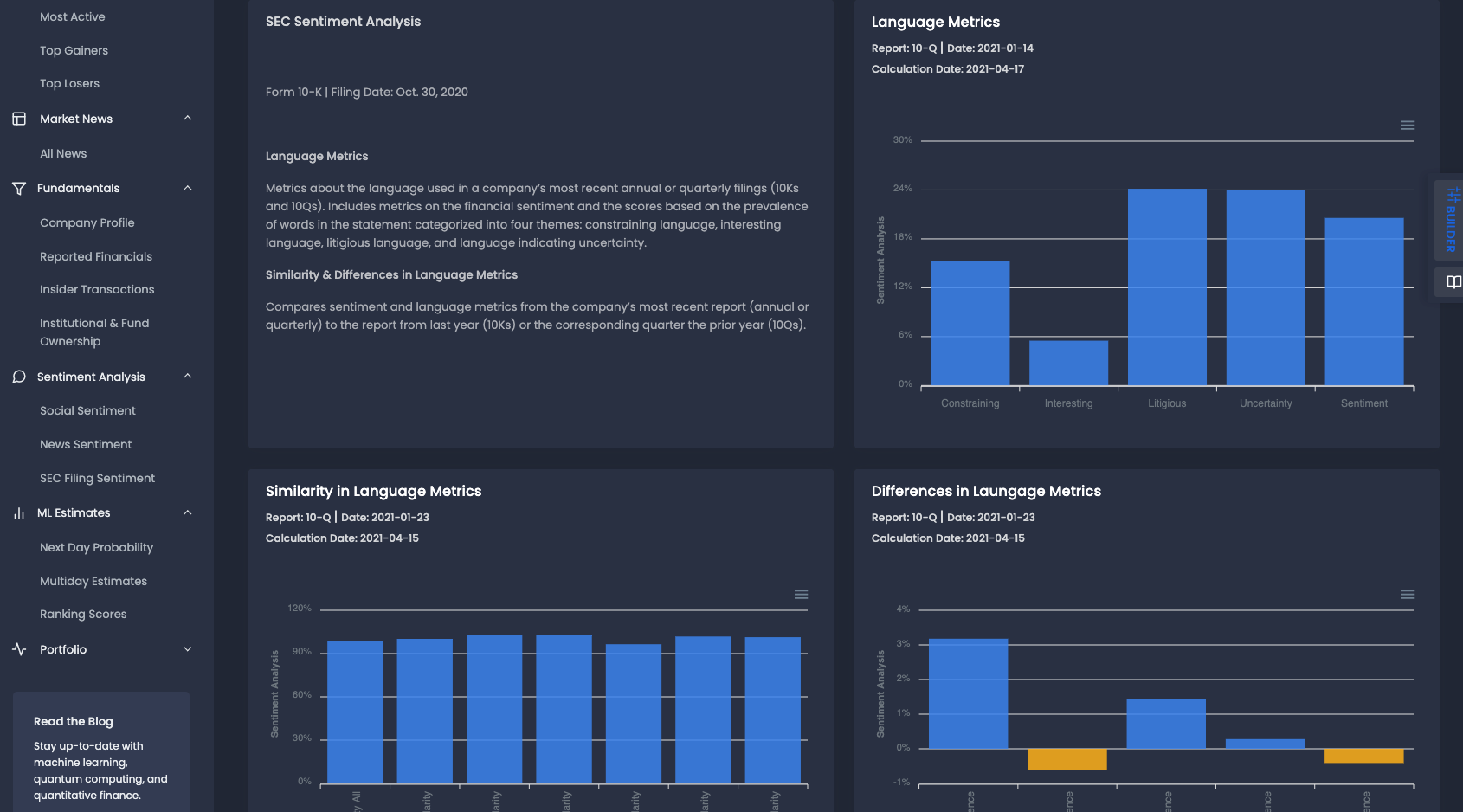
ML-Based Return Estimates
Another application of machine learning for trading is estimating returns. It should be noted that investors should never rely solely on return estimates as it is a notoriously difficult to predict with a high degree of accuracy. Instead, investors can use these estimates as a part of their research process—similar to how they can incorporate analyst estimates in their analysis.
In the MLQ app, we have ML-based estimates for both the probability of an up day or down day the following day, as well as multiday estimates.
Next Day Probability
In order to predict the next day's movement, this data provider uses six months of closing-price measurements and machine learning to calculate these probabilities:
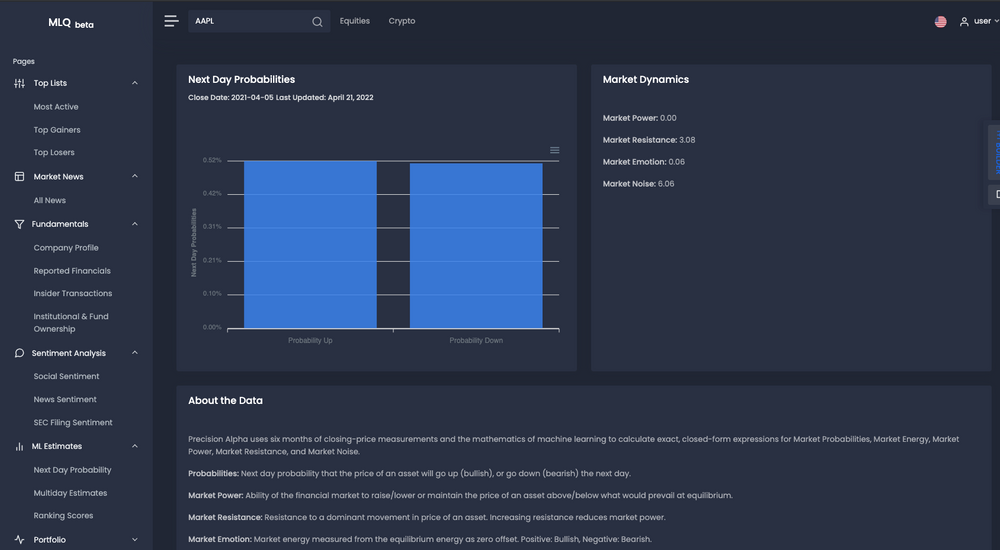
Multiday Return Estimates
In addition, the MLQ app uses a data provider that generates daily stock rankings based on the predicted future returns of a universe of around 1,000 stocks over 2, 3, 5, 10, and 21 days.
The model uses a voting scheme of machine learning classifiers that non-linearly combine a variety of features with a series of techniques aimed at mitigating the issue of overfitting financial data with a low signal to noise ratio.
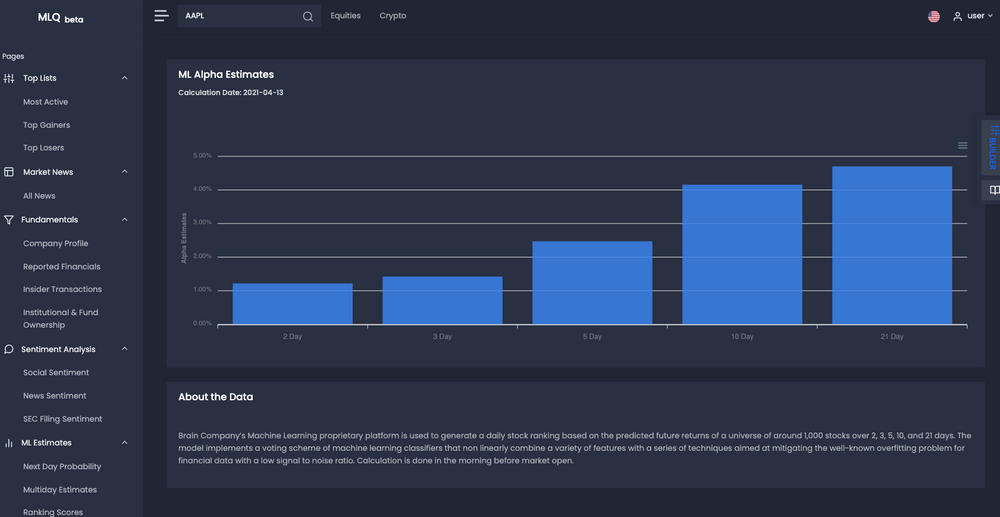
Stock Ranking Scores
Similar to return estimates, machine learning can be used to rank stocks and provide scores based on various factors.
For example, in the MLQ app the data provider takes in over 200 factors and signals including fundamentals, pricing, technical indicators, and alternative data, and then uses an ensemble machine learning technique to analyze and rank stocks.
The ranking scores providing include:
- K Score: A score indicative of how well-managed a company is and whether its financial strength is solid. Factors include but are not limited to: working capital to long-term debt ratio, Greenblatt ROC, dividend payout, and operating profitability.
- Quality Score: The ability of the financial market to raise/lower or maintain the price of an asset above/below what would prevail at equilibrium.
- Growth Score A score indicative of a stock’s growth and growth factors. Factors include but are not limited to: ROA/ROE three-year growth rate and sustainable earnings.
- Value Score A score indicative of whether a stock is overpriced or underpriced. Factors include but are not limited to: earnings yield, price to book, enterprise value to EBITDA, and price to sales.
- Momentum Score A score indicative of the stock’s momentum. Factors include but are not limited to: relative strength index, 52-week high/low, earnings momentum.
For quantitative investors, these ranking scores can be used as a signal in investment models. For example, a higher K Score indicates a higher probability of outperformance, whereas a lower K Score (1-3) indicates a lower probability of outperformance in the next month.
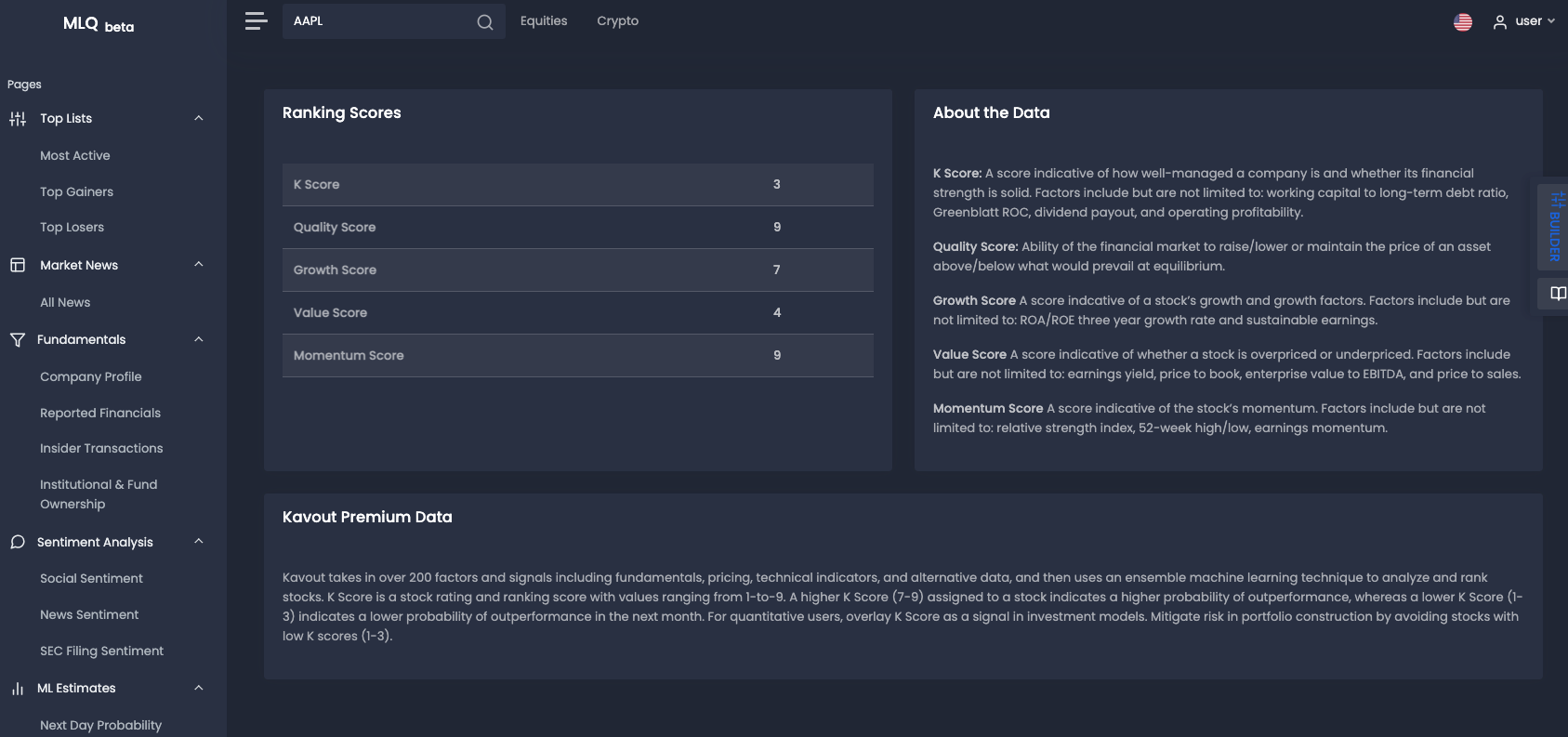
Crypto On-Chain Analysis
Machine learning can also be used to analyze publicly available blockchain data, otherwise known as on-chain analysis.
In the MLQ app, ML-based on-chain analysis data is sourced from an AI company that leverages machine learning and advanced statistics to extract intelligent signals for crypto-assets.
The trading signals include:
- New Network Growth
- Large Transactions
- Concentration
- In the Money
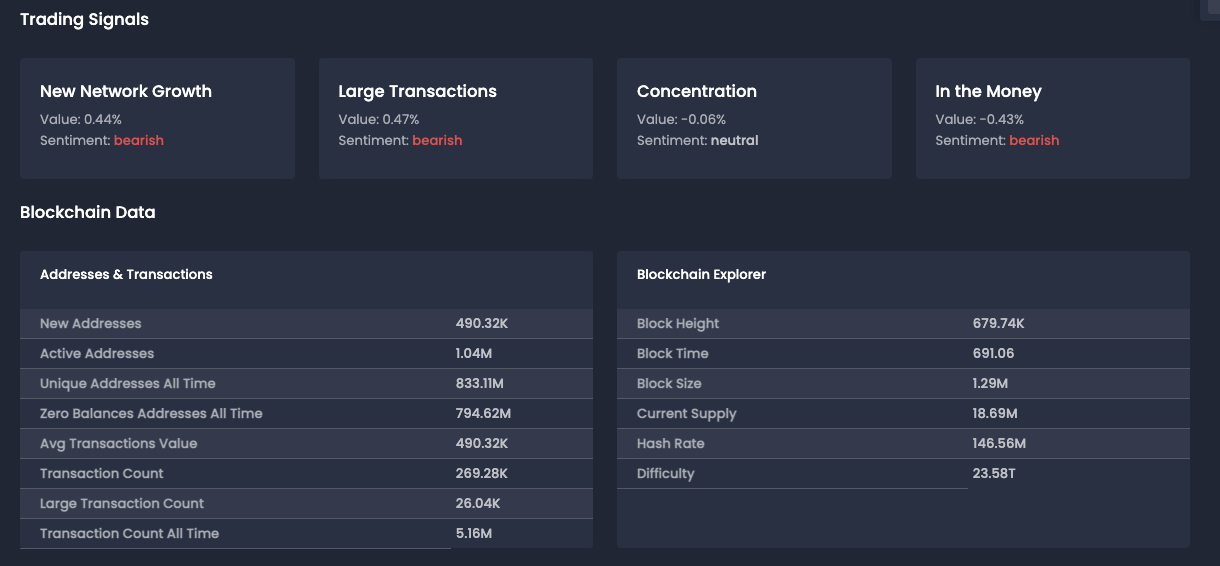
Synthetic Data
Another interesting application of machine learning for finance is generating synthetic financial data using Generative Adversarial Networks, or GANs.
In the context of trading and investing, GANs can be used to overcome several common problems such as:
- Data scarcity
- Data costs
- Backtest overfitting
As discussed in our guide to Synthetic Financial Data with GANs:
In order to overcome the limitations of data scarcity, privacy, and costs, GANs for generating synthetic financial data may prove to be essential in the adoption of AI.
Reinforcement Learning for Trading
Finally, another interesting application of machine learning in finance in reinforcement learning for trading. As discussed in our guide to deep reinforcement learning for trading:
Reinforcement learning is a branch of machine learning that is based on training an agent how to operate in an environment based on a system of rewards.
An RL trading strategy is similar to other quantitative systems — it receives data of the current market and acts on by either placing a trade or not. These signals can either go through approval of a human trader, or act 100% autonomously.
You can learn more about reinforcement learning and its application in trading here.
Summary: Applications of Machine Learning in Trading and Investing
As discussed, a few of the most common applications of machine learning for trading and investing include:
- Sentiment analysis, which can be used for social, news, or SEC filings
- ML-based return estimates
- Stock ranking scores
- On-chain analysis for cryptocurrencies
- Generating synthetic data using GANs
- Reinforcement learning for trading
It's important to note that some of these applications are much more challenging than others—for example generating synthetic data is much more difficult than generating a sentiment score of social data. That said, many of these applications are becoming increasingly popular in trading and investing, and this trend is likely going to continue in the coming years.
In order to help traders and investors make use of these advances in AI and machine learning, we built the MLQ app.
The platform combines fundamentals, alternative data, and ML-based insights for smarter trading and investing.
If you're interested in using AI and machine learning for investment research, you can create a free account here.






